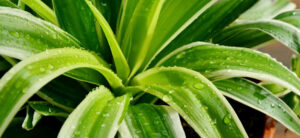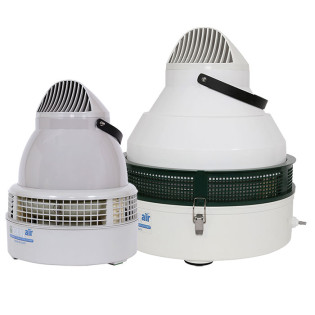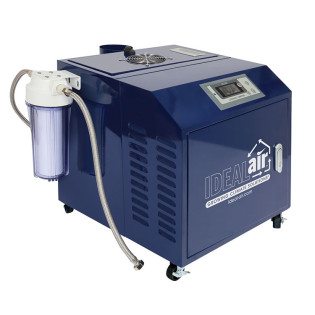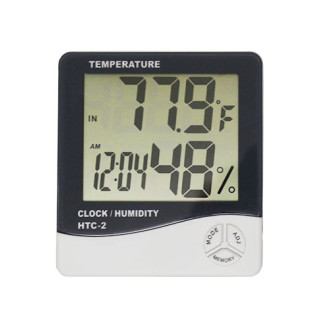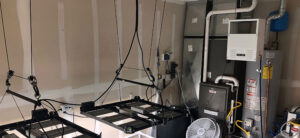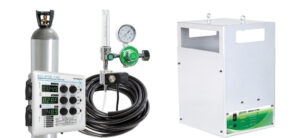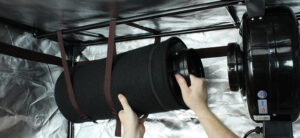
They say it’s not the heat that will get you, but the humidity - but when it comes to low humidity, plants can be particularly vulnerable.
Too much humidity can lead to illnesses like fungal disease and root rot. However, too little humidity can result in issues as well..
It can be tough to rectify low humidity in plants because it can show the same symptoms as plants that just need to be watered.. However, thoroughly watering won’t always fix low humidity symptoms in plants because it’s not the water in the soil that needs fixing - it’s the water in the air.
If you feel that this could be what your plants are suffering from, don’t worry. Today, we’re going to help you discover the signs of low humidity in plants along with tips to rectify the situation quickly.
What Is Considered Low Humidity For Plants?
Before we get into the meat and potatoes of this article,, we want to first explain what we mean by “low humidity.”
Relative humidity is the amount of water vapor in the air relative to the maximum amount of water vapor the air can hold at a given temperature.

For example, if the relative humidity is 75% at 80 degrees Fahrenheit, that means that every bit of the air in the respective space contains 75% of the maximum amount of water it could hold at that temperature.
At 75% humidity, the air will likely feel heavy and uncomfortable.
Because conditions of high humidity tend to be quite unbearable for us as humans, we tend to keep our homes at a relatively low humidity level. The average home has a humidity level of around 30% or less. But most plants, even those that prefer dry conditions such as succulents, prefer the humidity to be at 40% or higher.
Many even thrive at levels of 60% or more!
Conditions of low humidity can occur at all times of the year but tend to be most prevalent during the dry winter months. When you keep the heat circulating in your home 24/7, this sucks up all the available moisture in the air. In turn, it becomes difficult to keep indoor plants at the humidity level they need.
What Are The Low Humidity Symptoms In Plants?
As we mentioned earlier, low humidity symptoms can be difficult to diagnose because they are easily confused with low soil moisture conditions.
Often, you might misconstrue low humidity symptoms for underwatering or too much light when in reality, a lack of humidity is the culprit.
Leaves may turn brown and dry along their edges or tips. This is a key indicator in determining whether the issue is humidity or underwatering - humidity issues usually strike the tips of the plant while underwatering is most easily detected at the sides.
You may also notice that flowers and leaves dry up and begin to become shriveled. Other plants may curl leaves down or inward. This condition can even cause newly formed leaves to look deformed or misshapen.
The Easiest Way To Identify Low Humidity - Use A Hygrometer!
You don’t have to rely on just how your plants look or how the room feels to determine if your plants are dealing with low humidity.
There is no excuse these days - because every grow room or greenhouse should have a hygrometer on hand that provides 24/7 access to the conditions in your space - both in terms of humidity and temperature.
This way, all you have to do is quickly glance at the hygrometer to determine if humidity is too low, too high, or just right.
But once you’ve identified problems with your humidity levels - how do you rectify them?
How To Fix Low Humidity For Indoor Plants

The simplest way to fix low humidity for indoor plants is, of course, to elevate the humidity levels.
This is easier said than done though, especially when you consider that most plants prefer higher humidity levels than what us humans prefer to maintain indoors. There are a few ways you can raise humidity indoors to help your plants.
Try a Humidifier
Many people turn to humidifiers in the winter, when indoor humidity levels are far too low for even us to appreciate.
You can put a humidifier near your moisture-loving plants and program it to provide the perfectly regulated humidity that your plants need. Use a warm mist setting and choose distilled or filtered water to fill the humidifier.
The warm moisture provided by this setting will mimic that in which many humidity-loving tropical plants are naturally found growing. Some humidifiers have built-in hygrometers that will tell you when the desired level of humidity has been reached (some more advanced models even come with timers that will shut the machine off at that point).
If you can, program the humidifier to turn off once the desired levels have been reached (anywhere between 50 to 60% in most cases but some seeds and clones need up to 75%). You can also install a whole house humidifier, but this probably isn’t a great idea unless you want to turn your entire home into a greenhouse!
When you set up your humidifier, you’ll want to put it near fans to help circulate the humidity near the growing space.
Grow Plants in a More Humid Environment
An easy way to provide your plants with the humid conditions they need is to consider the environment. If you have any control over where you put your grow area, try to make sure it’s one that is humid and not exposed to too many drying drafts.
Group Similar Plants Together
You can also rectify low humidity by grouping certain plants together. By creating a “humidity island,” you’ll find that it’s much easier to give your plants what they need without having to turn your home into a haven for humidity.
Group all humidity-loving plants together. As they transpire, they will naturally increase the humidity around themselves creating a sort of microclimate within your own home.
Cloches, Terrariums, and More
Another option is to create a humid environment within a transparent little dome. This will likely only work for plants that can fit inside the container, such as your clones, but it can help provide plants with more moisture without elevating the humidity in your entire home.
Use Humidity Trays
You might also consider putting pebble trays filled with water beneath your plants. This is an easy way to increase the humidity around one specific plant.
Just make sure the pebbles hold the bottom of the pot above the water so that you don’t end up oversaturating the growing media.
Misting
Misting can work to increase humidity but it won’t have very long-lived effects. In fact, misting the leaves of your plants will only increase humidity for a few minutes.
Plus, if you over-mist your plants, it could also lead to fungal issues on the leaves - so exercise some caution if you turn to this trick.
What Are The Best Low Humidity Plants?
If you’re still struggling with low humidity, you may just want to reconsider what kinds of plants you are growing. Consider growing plants that like low humidity, such as:
Snake Plant
The snake plant, or mother-in-law’s tongue, is one excellent plant you can grow if you need to keep the humidity low. Not only can the plant withstand low humidity, but it also tolerates low light and varying temperatures with ease.
Cacti
Cactus plants are succulents that happily grow in low humidity conditions. They vary in terms of how much light, moisture, and humidity they need, but most like lots of sunlight and grow best in well-draining media.
Baby Rubber Plant
The baby rubber plant is a low-growing houseplant with dark green leaves. It has soft stems, like a succulent - but it’s not actually a member of this group. It can tolerate low humidity levels along with bright lighting.
Heartleaf Philodendron
The heartleaf philodendron is another low humidity plant you can grow. It survives in low light conditions and doesn’t require a lot of specific care or maintenance.
Final Thoughts On Identifying & Treating Low Humidity Symptoms In Plants
Indoor plants and low humidity don’t go together very well - therefore, it’s important that you pay attention to conditions in your grow room and ensure they meet your specific plant’s needs.
Although low humidity in plants isn’t always easy to address, the tips above should help you get your indoor growing environment back on track.
At Hydrobuilder, you’ll find all the gear you need to keep your plants happy and hydrated. We have a variety of residential and commercial-grade humidifiers that can cover up to 320 square feet (or be toned down to accommodate smaller areas if needed, too).
Most hook directly to your water supply so you won’t have to fuss with the installation process. Whether you’re growing in a small room in your home or a commercial greenhouse, you’ll be able to find everything you need to get started here.
Give your plants what they need to be healthy. At Hydrobuilder, we have all the humidifiers, grow tents, grow lights, and other products you need to create the perfect growing environment for any kind of plant.





